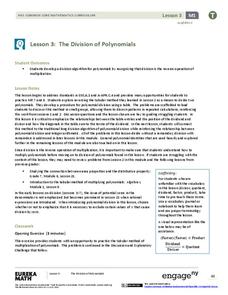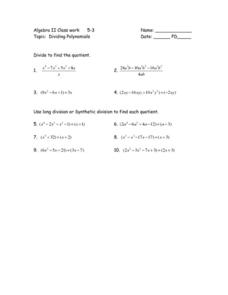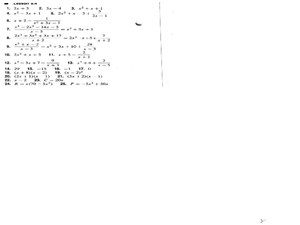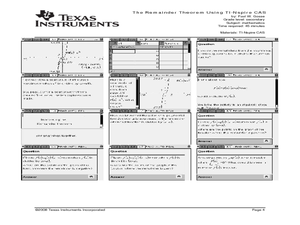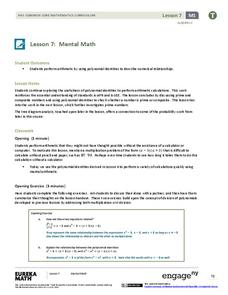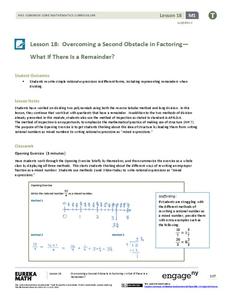EngageNY
Comparing Methods—Long Division, Again?
Remember long division from fifth grade? Use the same algorithm to divide polynomials. Learners develop a strategy for dividing polynomials using what they remember from dividing whole numbers.
West Contra Costa Unified School District
Polynomial Division
How do you apply the traditional division algorithm to polynomials? Here is an Algebra II lesson that extends the use of the division algorithm to polynomials. After establishing the concept of long division, synthetic division and the...
Flipped Math
Dividing Polynomials
Divide and conquer factoring. Learners see how dividing polynomials is similar to long division of numbers. Pupils learn how to use long division of polynomials to help find factors of higher degree polynomials. They then use their...
EngageNY
The Division of Polynomials
Build a true understanding of division of polynomials. Learners use their knowledge of multiplying polynomials to create an algorithm to divide polynomials. The area model of multiplication becomes the reverse tabular method of division.
Flipped Math
Calculus AB/BC - Integrating Functions Using Long Division and Completing the Square
With just a little work, integrals can become much easier. The 11th of 16 installments in Unit 6 - Integration has viewers watch a video to learn different ways to rewrite an integrand before determining the integral. They use polynomial...
Curated OER
Exercise Set 3.3: Dividing Polynomials
In this dividing polynomials worksheet, students divide 42 polynomials. Students factor polynomials using synthetic division and long division.
Curated OER
Long Division of Polynomials
In this long division of polynomials instructional activity, 6th graders solve and complete 7 different types of problems. First, they divide the first term of divisor into dividend. Then, students multiply new term of quotient by both...
West Contra Costa Unified School District
Polynomial Division
Multiply the ways your scholars can find the quotient with polynomial division. A lesson plan introduces polynomial division via long division, synthetic division, generic area model, and using the definition of division. Learners then...
Mt. San Antonio Collage
Synthetic Division and Zeros of Polynomial Functions
More than just a worksheet, this guide provides the description of many of the polynomials theorems to assist the learners. Starting with synthetic division, class members are then guided through the remainder theorem and linear factors.
Curated OER
Roots of Polynomial Functions
Here is a unit test on finding factors and zeros of higher-degree polynomials that could be used as a review or practice test. The Remainder Theorem, Rational Zero Theorem, and Factor Theorem are put into use. While this four-page...
Curated OER
Dividing Polynomials by Binomials
In this polynomial worksheet, students use long division or synthetic division to divide polynomials by binomials. This one-page worksheet contains ten problems, with answers.
Curated OER
Topic: Dividing Polynomials
In this polynomials activity, students use Synthetic division or long division to find the quotient of each polynomial. There are 10 problems to solve.
Curated OER
Dividing Polynomials
In this Algebra II/college level worksheet, students use long and synthetic division to divide polynomials and use the Factor Theorem to show that a given polynomial is a factor of a polynomial function. The two page worksheet contains...
Curated OER
Long Division of Polynomials
In this polynomial activity, learners simplify problems through the use of division. This three-page activity contains examples, followed by ten problems.
Curated OER
More on Factors, Zeros, and Dividing
Students explore the concept of finding zeros of polynomials. In this finding zeros of polynomials activity, students find the zeros of polynomials given one zero. Students factor and find all the zeros of 18 polynomials.
EngageNY
Dividing by (x – a) and (x + a)
Patterns in math emerge from seemingly random places. Learners explore the patterns for factoring the sum and differences of perfect roots. Analyzing these patterns helps young mathematicians develop the polynomial identities.
Curated OER
Using Long Division
In this algebra worksheet, learners divide polynomials using long division. They write the answer in fractional form. There are 30 questions.
Curated OER
The Remainder Theorem Using TI-Nspire CAS
Investigate the Remainder Theorem in this algebra lesson. Explore the relationship between the remainders of polynomial division and the function. Each of the four problems gets progressively more complicated. This might be a great...
EngageNY
Mental Math
Faster than a speedy calculator! Show your classes how to use polynomial identities to multiply numbers quickly using mental math.
EngageNY
Overcoming a Second Obstacle in Factoring—What If There Is a Remainder?
Looking for an alternative approach to long division? Show your classes how to use factoring in place of long division. Increase their fluency with factoring at the same time!
EngageNY
Polynomial, Rational, and Radical Relationships
This assessment pair goes way beyond simple graphing, factoring and solving polynomial equations, really forcing learners to investigate the math ideas behind the calculations. Short and to-the-point questions build on one another,...
Curated OER
Polynomial Divisions
Pupils factor polynomials and use long division t solve problems. In this algebra lesson, students find the zeros of polynomials by synthetic and long division. They perform operation using complex numbers.
Curated OER
Lesson 19: Rational Functions and Long Division
Explore rational functions with this packet. A lot of information is provided, including several examples. Learners graph rational functions and find vertical, horizontal, and oblique asymptotes. This seven-page activity contains...
Curated OER
Polynomials
In this College algebra learning exercise, students determine the degree of polynomials. Students add, subtract, multiply, divided and factor polynomials. The two page learning exercise contains thirty-eight problems. Answers are no...





